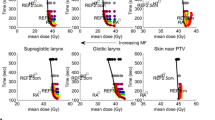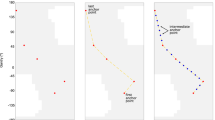Aim:
This communication reviews the planning strategies and dose statistics of nine IMRT plans generated for a complex head and neck case.
Patient and Method: An ethmoid sinus cancer case was sent as an IMRT planning task to all participants of the ESTRO course on “IMRT and Other Conformal Techniques in Practice”, held in Amsterdam in June 2001.
Results: Nine IMRT plans were generated for the case, the majority of the plans generated with commercial planning systems. The number of beam incidences ranged between four and eleven, while five of the nine beam setups were coplanar. The planning target volume dose homogeneity was inversely correlated with the degree of sparing of the surrounding organs at risk.
Conclusion: IMRT strategies for complex head and neck cases, such as ethmoid sinus cancer, can be strikingly different in various aspects, such as beam setup, total number of segments, PTV dose coverage and dose statistics for organs at risks.
Ziel:
Diese Kurzmitteilung beschreibt und vergleicht die Planungsstrategien und Dosisstatistiken von neun IMRT-Plänen für einen Nasennebenhöhlentumor.
Patient und Methode: Die Planung einer intensitätsmodulierten Strahlenbehandlung (IMRT) für einen Nasennebenhöhlentumor im Siebbein wurde den Teilnehmern des ESTRO-Kurses “IMRT and Other Conformal Techniques in Practice” in Amsterdam im Juni 2001 als Aufgabe gestellt.
Ergebnisse: Für den vorgegebenen Fall wurden neun intensitätsmodulierte Bestrahlungspläne erstellt, die Mehrzahl unter Verwendung kommerzieller Bestrahlungsplanungssysteme. Die Zahl der Einstrahlrichtungen variierte zwischen vier und elf, fünf der neun Strategien verwendeten ausschließlich koplanare Einstrahlrichtungen. Die Homogenität der Dosisverteilung im Planungszielvolumen korrelierte invers mit dem Schonungsgrad der umliegenden Risikostrukturen.
Schlussfolgerung: IMRT-Planungsstrategien für komplexe HNO-Fälle, wie beispielsweise Nasennebenhöhlentumoren, weisen für eine Vielzahl von Aspekten, wie Zusammenstellung der Felder, Gesamtzahl der Segmente, Homogenität der Dosisdeposition im Planungszielvolumen oder Dosisstatistik der Risikostrukturen, auffallende Unterschiede auf.
Similar content being viewed by others
Author information
Authors and Affiliations
Additional information
Received: February 2, 2002; accepted: May 16, 2002
Correspondence Address Filip Claus, MD, Ghent University Hospital, Division of Radiotherapy P7, De Pintelaan 185, 9000 Ghent, Belgium, Phone (+32/32) 92403-074, Fax -863, e-mail: filip@krtkg1.rug.ac.be
Rights and permissions
About this article
Cite this article
Claus, F., Mijnheer, B., Rasch, C. et al. Report of a Study on IMRT Planning Strategies for Ethmoid Sinus Cancer. Strahlenther Onkol 178, 572–576 (2002). https://doi.org/10.1007/s00066-002-0999-3
Issue Date:
DOI: https://doi.org/10.1007/s00066-002-0999-3




